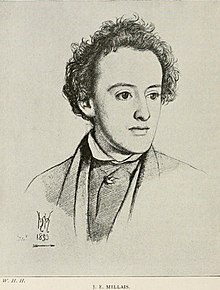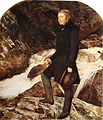John Everett Millais
Sir John Everett Millais, 1st Baronet [ ˈmilɛː ] PRA (born June 8, 1829 in Southampton , † August 13, 1896 in London ) was a British painter from the Pre-Raphaelite circle . Millais was the first artist to be bestowed the hereditary title of baronet .
Life
John Everett Millais came from a middle-class Jersey family . His parents were John William Millais (1800-1870) and Mary Evamy (1789-1864). Between 1833 and 1838 he lived in St. Helier , Jersey, and in Dinan , Brittany. As a child prodigy, he attended Sass' Art School from 1838 to 1839 and won a silver medal from the Royal Society of Arts at the age of nine . In 1840, at the age of eleven, he was admitted - the youngest member of all time - to the Royal Academy of Arts in London by Sir Martin Archer Shee , which he successfully completed by 1847. Here he was called "the child". In 1843 he received the silver medal for a drawing of antiquity. His painting The Tribe of Benjamin Seizing the Daughters of Shiloh was awarded a gold medal in 1847. In 1846 he was represented for the first time at the exhibition of the Royal Academy with his picture Pizarro Seizing the Inca of Peru (1.28 × 1.72 m).
In July 1848 the Cyclographic Society was founded with the members: Everett Millais, Frederic George Stephens , Thomas Woolner , James Collinson , Walter Howell Deverell as well as Holman Hunt and Dante Gabriel Rossetti . Her designs circulated in this circle, e.g. B. the drawing by Rossetti Gretchen in Church , which was criticized by Millais. However, this company was dissolved again at the end of August. Instead, they formed the Pre-Raphaelite Brotherhood , which was to become a fellowship rather than a real collaboration.
With William Holman Hunt , whom he had met at the academy, he maintained a joint studio from 1848. Millais was one of the founding members of the Pre-Raphaelite Brotherhood in 1848 and the most talented of them all.
In 1849 he exhibited his first Pre-Raphaelite picture in the Academy: Isabella , inspired by a poem by John Keats .
His painting Christ in His Parents' House sparked public protest in 1850. The support of John Ruskin changed public opinion in 1851, Millais showed Ophelia in 1852 . In 1853 he visited Scotland at the invitation of John Ruskin, whom he portrayed. In 1855 he married Effie , Ruskin's wife, after their marriage was annulled. The couple had seven children. To avoid the scandal in London society, they lived in Scotland until 1861.
By 1856 Millais had perfected his painting technique and was restlessly looking for new ways to express himself. He had realized that the precision of painting in the Pre-Raphaelite style was only one step in his development.
In 1861 he moved back to London with the family. Here he had great success with his children's pictures. His picture A Child's World by his grandson, which became famous under the name "Bubbles", became particularly well known . The following story is related: The picture exhibited in the Tooth & Sons Gallery, 5 and 6 Haymarket, London, in the spring of 1886 was bought by Sir Ingram, owner of Illustrated London News . He wanted to use them to make printing plates for the 1886 Christmas greetings. Thomas J. Barratt of A. & F. Pears saw the picture in Sir Ingram's office and bought it from him. The company Pears was a soap manufacturer and the boy with the soap bubbles ("Bubbles") from Millais became very well known as a soap advertisement for the company, which wanted to appeal to the higher earners.
In 1863 Millais was elected to the Royal Academy. By the late 1860s, Millais had become an extremely popular artist, including through book illustrations, history, genre and event pictures. He made a handsome income from selling licenses to publish his works as intaglio prints. From 1870 he worked successfully as a society painter and portraitist and received numerous international awards, including the Prussian order Pour le Mérite , the Belgian Leopold order and the French Légion d'honneur . In 1882 Millais was accepted as a foreign member of the Académie des Beaux-Arts .
On July 16, 1885, Queen Victoria ennobled him with the hereditary title of Baronet, of Palace Gate, in the Parish of St. Mary Abbot, Kensington , in the County of Middlesex , and of Saint Ouen, in the Island of Jersey . In 1886 the Grosvenor Gallery exhibited 159 of his works. Later his works were also shown at the Glasgow Institute of the Fine Arts .
In 1889 he was instrumental in setting up the National Portrait Gallery in London. In 1896, a few months before his death, the Royal Academy appointed Sir John Everett Millais as its President.
He died on August 13, 1896 in Kensington, London, and was buried in St. Paul's Cathedral. His eldest son Everett Millais (1856-1897) inherited his title of nobility as 2nd baronet.
The paintings from his studio were auctioned at Christie's on May 1, 1897, March 21, and July 2, 1898.
plant
Millais 'painting Christ in His Parents ' House , commonly called The Carpenter's Shop at the time , triggered one of the Royal Academy's biggest scandals when it was exhibited in the spring of 1850 . Faithfulness to nature was seen as blasphemy and in Millais “papist” tendencies, a not inconsiderable reproach in a religiously intolerant England at the time. One of the fiercest opponents was the writer Charles Dickens . He complained: "A hideous, crooked-necked, flaming redhead in a nightgown" . And about Maria: she was "so repulsive in her ugliness that she would stand out as a monster even in the most vulgar French tingle and the most shabby English bar" .
Queen Victoria was so troubled by the fuss that was being made about the Pre-Raphaelite that she had some pictures brought to her palace. Consideration was given to banning the Pre-Raphaelites from the Academy's annual exhibitions. Then John Ruskin , whose opinion was highly regarded by the public, came to their aid with two letters to the editor to the Times . The public attention and the laudatory criticism of Ruskin spurred the Pre-Raphaelites.
Millais illustrated a number of literary texts by well-known writers, including the novels Anthony Trollopes and the Moxon edition of Alfred Tennyson's Poems from 1857.
In the 1870s, he mainly portrayed public figures such as Thomas Carlyle (1877), Lillie Langtry (1878), Gladstone (1879 and 1885), Disraeli (1881) and Tennyson (1881). It is believed that Millais did this also for financial reasons to support his large family.
His paintings of beautiful young women were also very popular, such as B. Stella 1868. In the style of Sir Joshua Reynolds he painted “Hearts are Trumps” in 1872, the three daughters of Walter Armstrong - Elizabeth, Diana and Mary playing cards.
Important works
- Christ in the house of his parents , 1849/1850; London, Tate Gallery
- 'Isabella', 1848-49 Walker Art Gallery collection Curator's choice - Millais's 'Isabella'
- Mariana , 1850/1850 , oil on mahogany, 59.7 × 49.5 cm; Previously privately owned, owned by Tate Britain since 1999, offset against tax debt. Picture review of the Kahn Academy
- The Huguenot , 1851/1852; exhibited at the Royal Academy in 1852 as 'A Huguenot, on St Bartholemew's Day, Refusing to Shield Himself from Danger by Wearing the Roman Catholic Badge'. Washington, Makins Collection Picture review in the Victorian Web Composition and its Consequences in Millais's A Huguenot on St. Bartholomew's Day
- Ophelia , 1851/1852; London, Tate Gallery “Ophelia” picture review
- Portrait of John Ruskin , 1853/1854; Ashmolean Museum , Oxford
- Autumn Leaves, 1855/1856 , Manchester Art Gallery
- Image description for "Peace Concluded" 1856 - End of the Crimean War - The Putnam Dana McMillan Fund
- The Black Brunswicker , 1860; Picture review. Liverpool, Lady Lever Art Gallery
- Apple Blossom Apple Blossoms or Spring. 1858-59
- The North-West Passage 1874 at the Tate Gallery
- The Princes in the Tower , 1878, Holloway College, University of London
- John Henry Newman , portrait, 1881
→ See also Chronological list of Milais' work in oil, water and black and white in: The Life and Letters of Sir John Everett Millais. Volume - II ( digitized version )
gallery
literature
- Günter Metken: Pre-Raphaelites . Exhibition catalog Baden-Baden 1973–1974; Pp. 103-133
- Exhibition catalog Tate Britain: Pre-Raphaelites. Victorian Avant-Garde , London 2012, ISBN 978-1-84976-015-7 .
- Suzanne Fagence Cooper: The Model Wife: Effie, Ruskin and Millais . Ed .: Duckworth Publishing 2011. ISBN 978-0-7156-4144-6
- Jason Rosenfeld: John Everett Millais . Ed .: Phaidon Press Ltd (August 27, 2012) ISBN 978-0-7148-3977-6
- Biography written by his son John Guille Millais: The Life and Letters of Sir John Everett Millais. Volume I. Ed .: Methuen & Co., London 1899
- The Life and Letters of Sir John Everett Millais. Volume - II Ed .: Frederick A. Stokes Company, New York, 1899
- Chronologically in: The Life and Letters of Sir John Everett Millais. Volume - II
- George Somes Layard: Tennyson and his pre-Raphaelite illustrators . A book about a book. Ed .: Elliot Stock, London 1894
Individual evidence
- ↑ The small encyclopedia , Encyclios-Verlag, Zurich, 1950, volume 2, page 171
- ^ Art training in mid-Victorian Britain: Sass’s
- ↑ "Pizarro Seizing the Inca of Peru" in the V & A Museum
- ^ Early Pre-Raphaelite drawing style
- ↑ 1848 Rosetti Archive Chronology
- ↑ 'Isabella', John Everett Millais, 1848-49 in the Walker Art Gallery collection ( Memento from October 16, 2012 in the Internet Archive )
- ^ Pre-Raphaelite Online Resource: John Everett Millais
- ↑ The original painting was entitled 'A Child's World' and the model was Sir John Everett Millais' grandson
- ^ Charles Mosley: Burke's Peerage, Baronetage & Knightage. Volume 2, Burke's Peerage, Wilmington 2003, p. 2694.
- ^ The London Gazette : 25490, 3239 , July 14, 1885.
- ^ Günter Metken, Pre-Raphaelites (1973/74), p. 103
- ^ Günter Metken: Pre-Raphaelites (1973/74), p. 113
- ↑ “Stella” in the Manchester City Art Gallery.
- ^ Cleaning and restoration of the painting from John Everett Millais's "Hearts are Trumps" 1872
Web links
- John Everett Millais at Google Arts & Culture
- Search for John Everett Millais in the German Digital Library
- Search for "John Everett Millais" in the SPK digital portal of the Prussian Cultural Heritage Foundation
- Works by John Everett Millais at Zeno.org .
- Pre-Raphaelite Online Resource: John Everett Millais Birmingham Museums and Art Gallery
- Obituary of Sir John Everett Millais The Times , 14th August 1896
- Millais in the Art Renewal Center - with curriculum vitae and pictures
- Sir John Everett Millais, 1st Bt. In the National Portrait Gallery
- John Everett Milais paintings in the BBC Public Catalog Foundation
- 7 portraits by Pre-Raphaelites painters - on loan to the Tate Britain exhibition, London, 'Pre-Raphaelites: Victorian Avant Garde'
- Pre-Raphaelites: Victorian Avant-Garde - Exhibition at the Tate Gallery from September 12, 2012 - January 13, 2013
- Pre-Raphelites and their models
- Sir John Everett Millais, 1st Bt. On thepeerage.com
| predecessor | Office | successor |
|---|---|---|
| New title created | Baronet, of Palace Gate and St Ouen 1885-1896 |
Everett Millais |
| personal data | |
|---|---|
| SURNAME | Millais, John Everett |
| ALTERNATIVE NAMES | Millais, Sir John Everett, 1st Baronet |
| BRIEF DESCRIPTION | British painter |
| DATE OF BIRTH | June 8, 1829 |
| PLACE OF BIRTH | Southampton |
| DATE OF DEATH | August 13, 1896 |
| Place of death | London |












